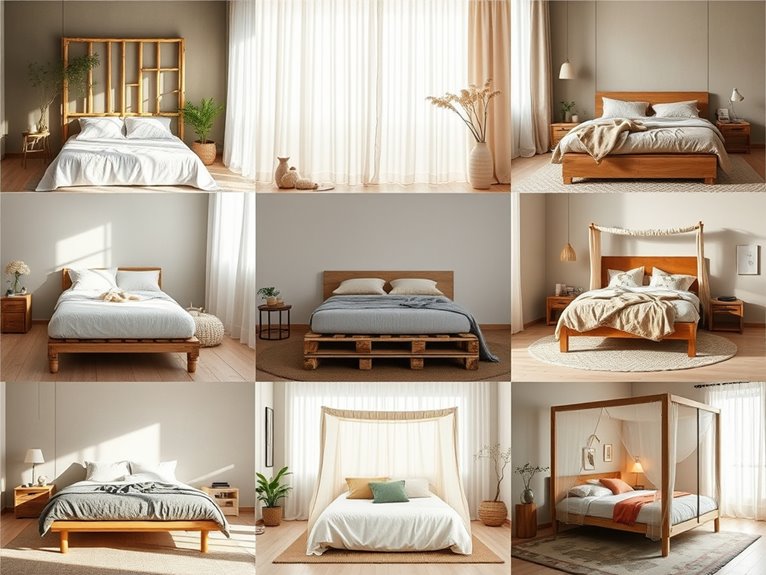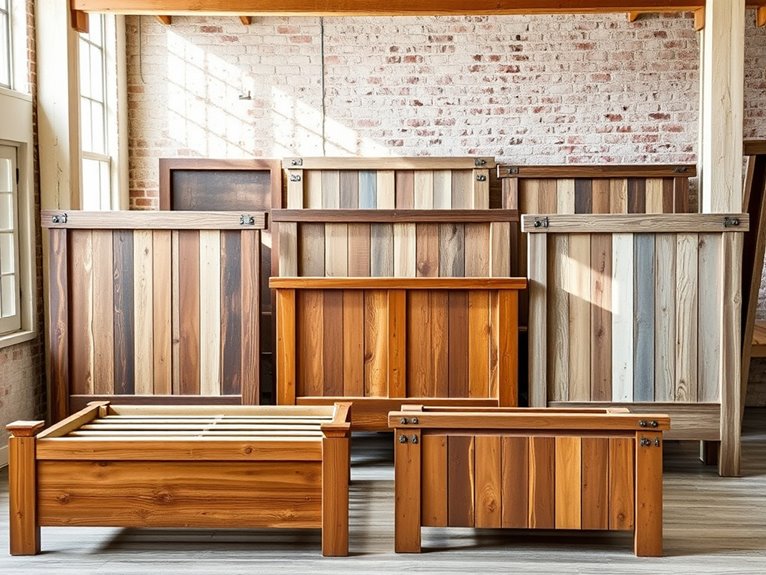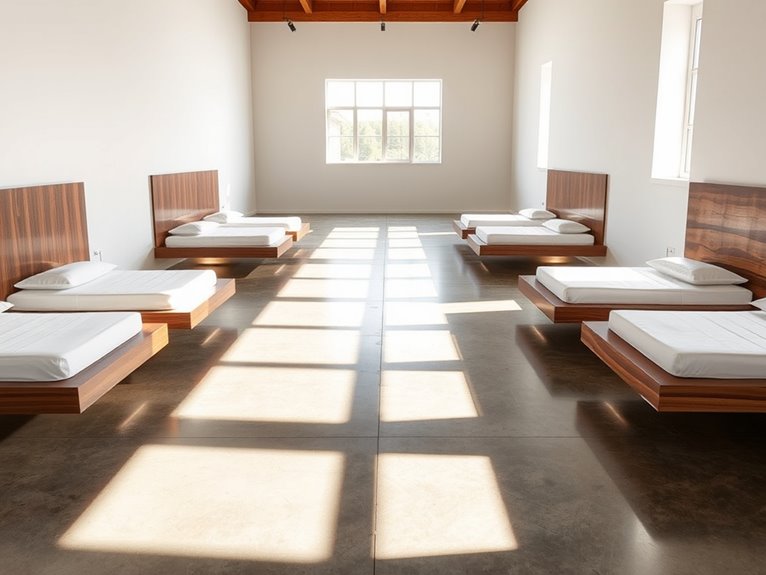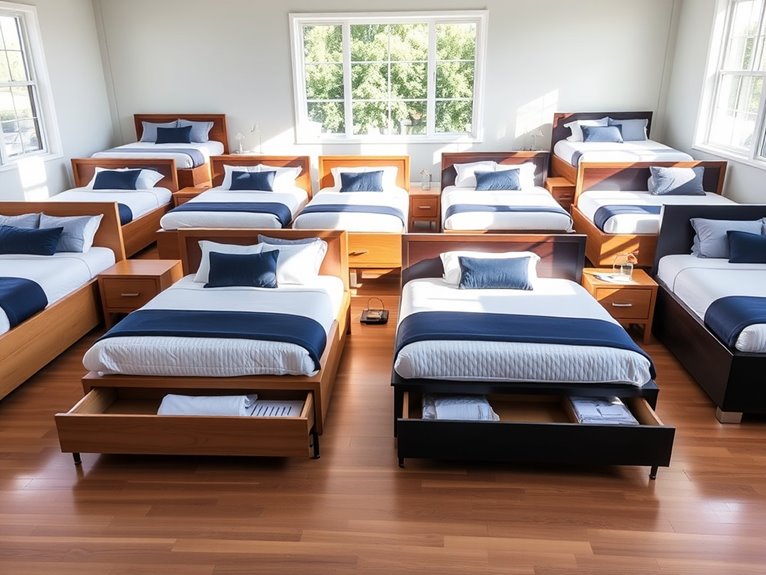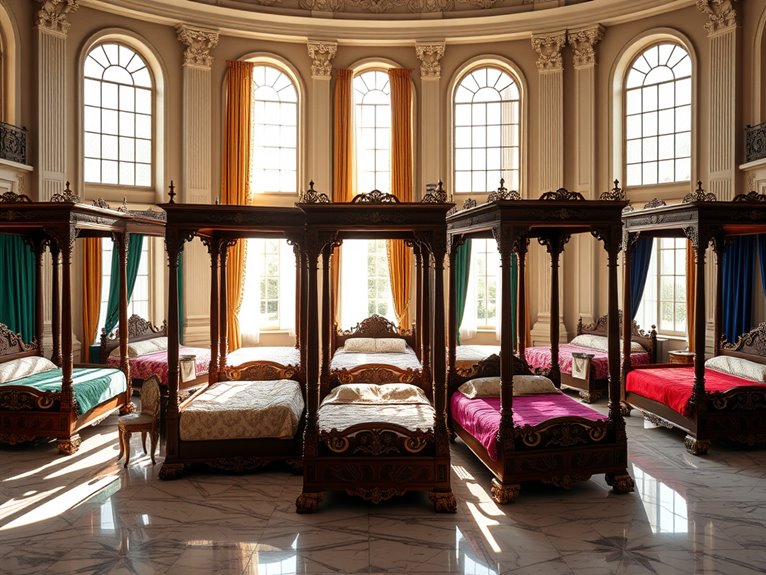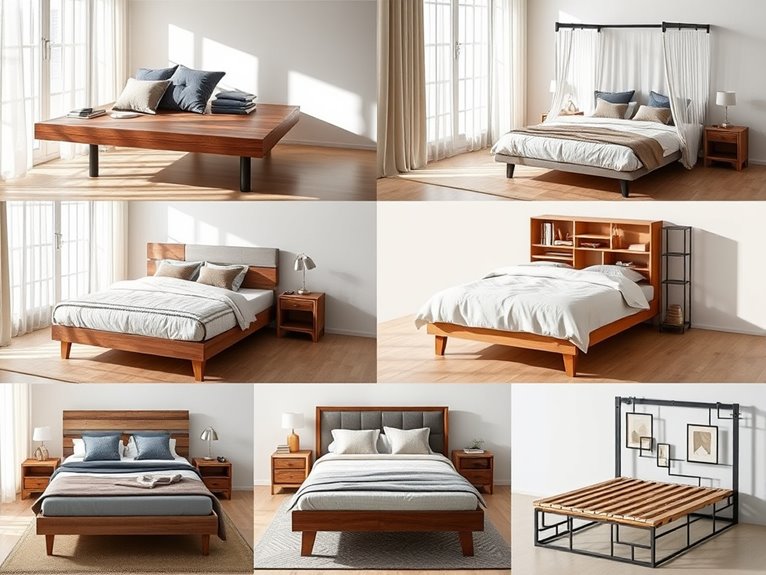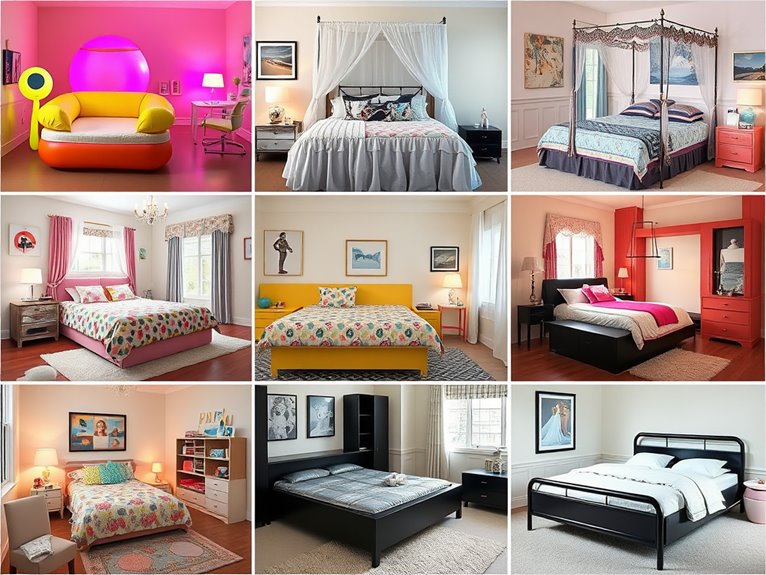8 Sustainable Bed Ideas
Warning: Attempt to read property "title" on array in /var/www/bedbasics.design/wp-content/plugins/affiai/includes/afx-shortcode.php on line 10
Warning: Trying to access array offset on value of type null in /var/www/bedbasics.design/wp-content/plugins/affiai/includes/afx-shortcode.php on line 10
Warning: Undefined variable $price in /var/www/bedbasics.design/wp-content/plugins/affiai/includes/afx-shortcode.php on line 10
Warning: Attempt to read property "title" on array in /var/www/bedbasics.design/wp-content/plugins/affiai/includes/afx-shortcode.php on line 10
Warning: Trying to access array offset on value of type null in /var/www/bedbasics.design/wp-content/plugins/affiai/includes/afx-shortcode.php on line 10
Warning: Attempt to read property "title" on array in /var/www/bedbasics.design/wp-content/plugins/affiai/includes/afx-shortcode.php on line 10
Warning: Trying to access array offset on value of type null in /var/www/bedbasics.design/wp-content/plugins/affiai/includes/afx-shortcode.php on line 10
Warning: Attempt to read property "title" on array in /var/www/bedbasics.design/wp-content/plugins/affiai/includes/afx-shortcode.php on line 10
Warning: Trying to access array offset on value of type null in /var/www/bedbasics.design/wp-content/plugins/affiai/includes/afx-shortcode.php on line 10
Warning: Attempt to read property "title" on array in /var/www/bedbasics.design/wp-content/plugins/affiai/includes/afx-shortcode.php on line 10
Warning: Trying to access array offset on value of type null in /var/www/bedbasics.design/wp-content/plugins/affiai/includes/afx-shortcode.php on line 10
Warning: Attempt to read property "title" on array in /var/www/bedbasics.design/wp-content/plugins/affiai/includes/afx-shortcode.php on line 10
Warning: Trying to access array offset on value of type null in /var/www/bedbasics.design/wp-content/plugins/affiai/includes/afx-shortcode.php on line 10
Warning: Attempt to read property "title" on array in /var/www/bedbasics.design/wp-content/plugins/affiai/includes/afx-shortcode.php on line 10
Warning: Trying to access array offset on value of type null in /var/www/bedbasics.design/wp-content/plugins/affiai/includes/afx-shortcode.php on line 10
Warning: Attempt to read property "title" on array in /var/www/bedbasics.design/wp-content/plugins/affiai/includes/afx-shortcode.php on line 10
Warning: Trying to access array offset on value of type null in /var/www/bedbasics.design/wp-content/plugins/affiai/includes/afx-shortcode.php on line 10
Warning: Attempt to read property "title" on array in /var/www/bedbasics.design/wp-content/plugins/affiai/includes/afx-shortcode.php on line 10
Warning: Trying to access array offset on value of type null in /var/www/bedbasics.design/wp-content/plugins/affiai/includes/afx-shortcode.php on line 10
Warning: Attempt to read property "title" on array in /var/www/bedbasics.design/wp-content/plugins/affiai/includes/afx-shortcode.php on line 10
Warning: Trying to access array offset on value of type null in /var/www/bedbasics.design/wp-content/plugins/affiai/includes/afx-shortcode.php on line 10
Warning: Attempt to read property "title" on array in /var/www/bedbasics.design/wp-content/plugins/affiai/includes/afx-shortcode.php on line 10
Warning: Trying to access array offset on value of type null in /var/www/bedbasics.design/wp-content/plugins/affiai/includes/afx-shortcode.php on line 10
Warning: Undefined variable $price in /var/www/bedbasics.design/wp-content/plugins/affiai/includes/afx-shortcode.php on line 10
Warning: Attempt to read property "title" on array in /var/www/bedbasics.design/wp-content/plugins/affiai/includes/afx-shortcode.php on line 10
Warning: Trying to access array offset on value of type null in /var/www/bedbasics.design/wp-content/plugins/affiai/includes/afx-shortcode.php on line 10
Warning: Attempt to read property "title" on array in /var/www/bedbasics.design/wp-content/plugins/affiai/includes/afx-shortcode.php on line 10
Warning: Trying to access array offset on value of type null in /var/www/bedbasics.design/wp-content/plugins/affiai/includes/afx-shortcode.php on line 10
Warning: Attempt to read property "title" on array in /var/www/bedbasics.design/wp-content/plugins/affiai/includes/afx-shortcode.php on line 10
Warning: Trying to access array offset on value of type null in /var/www/bedbasics.design/wp-content/plugins/affiai/includes/afx-shortcode.php on line 10
Warning: Attempt to read property "title" on array in /var/www/bedbasics.design/wp-content/plugins/affiai/includes/afx-shortcode.php on line 10
Warning: Trying to access array offset on value of type null in /var/www/bedbasics.design/wp-content/plugins/affiai/includes/afx-shortcode.php on line 10
Warning: Attempt to read property "title" on array in /var/www/bedbasics.design/wp-content/plugins/affiai/includes/afx-shortcode.php on line 10
Warning: Trying to access array offset on value of type null in /var/www/bedbasics.design/wp-content/plugins/affiai/includes/afx-shortcode.php on line 10
Warning: Attempt to read property "title" on array in /var/www/bedbasics.design/wp-content/plugins/affiai/includes/afx-shortcode.php on line 10
Warning: Trying to access array offset on value of type null in /var/www/bedbasics.design/wp-content/plugins/affiai/includes/afx-shortcode.php on line 10
Warning: Attempt to read property "title" on array in /var/www/bedbasics.design/wp-content/plugins/affiai/includes/afx-shortcode.php on line 10
Warning: Trying to access array offset on value of type null in /var/www/bedbasics.design/wp-content/plugins/affiai/includes/afx-shortcode.php on line 10
Warning: Attempt to read property "title" on array in /var/www/bedbasics.design/wp-content/plugins/affiai/includes/afx-shortcode.php on line 10
Warning: Trying to access array offset on value of type null in /var/www/bedbasics.design/wp-content/plugins/affiai/includes/afx-shortcode.php on line 10
Warning: Attempt to read property "title" on array in /var/www/bedbasics.design/wp-content/plugins/affiai/includes/afx-shortcode.php on line 10
Warning: Trying to access array offset on value of type null in /var/www/bedbasics.design/wp-content/plugins/affiai/includes/afx-shortcode.php on line 10
You’re about to discover how sustainable bed designs can transform your bedroom into an eco-conscious sanctuary. From the warm, weathered appeal of reclaimed wood frames to the sleek simplicity of bamboo platforms, these earth-friendly options offer both style and environmental stewardship. Each choice brings unique textures, natural materials, and thoughtful craftsmanship to your space, while reducing your carbon footprint. Let’s explore how these innovative bed solutions can help you create the sustainable bedroom of your dreams.
Reclaimed Wood Bed Frames
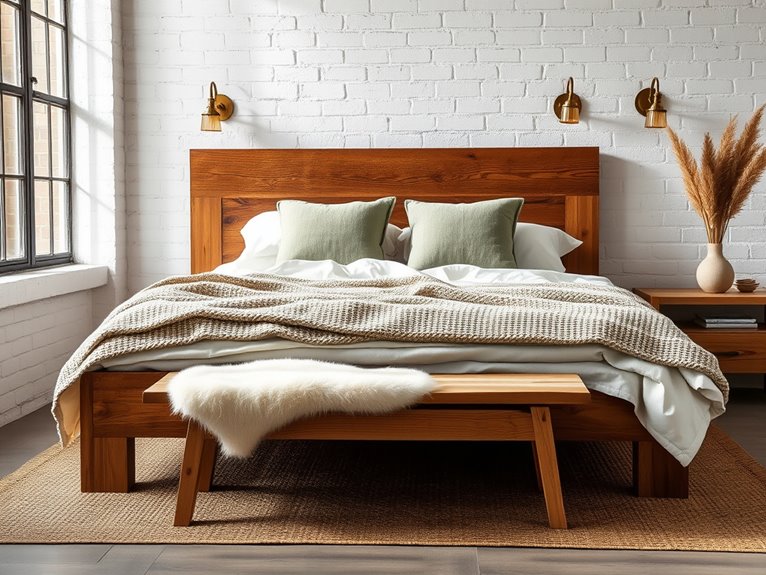
The raw, weathered charm of reclaimed wood bed frames brings an irreplaceable authenticity to bedroom spaces, combining environmental consciousness with timeless design. Each piece tells a unique story through its distinctive grain patterns, nail holes, and natural imperfections, creating a focal point that grounds the entire room in organic beauty and historical significance.
Reclaimed wood bed frames work particularly well in rustic farmhouse, industrial, or modern organic design schemes, offering versatility throughout all seasons. During warmer months, the natural wood tones create a breezy, casual atmosphere, while in winter, they provide warmth and coziness when paired with chunky knit throws and plush bedding. This sustainable choice works especially well in spaces with exposed brick, natural light, or industrial elements.
Essential Components:
- Reclaimed wood bed frame
- Organic cotton mattress
- Natural fiber sheets
- Wool or cotton duvet
- Linen pillow shams
- Decorative throw pillows
- Natural fiber throw blanket
- Metal brackets and hardware
- Non-toxic wood sealant
- Support slats
- Center support beam
How to Achieve This Look
Begin by selecting reclaimed wood with character that matches your room’s color palette. Look for pieces with varying tones, from honey-warm to weathered gray, ensuring the wood has been properly treated and sealed for indoor use. Consider the height of your frame carefully, as reclaimed wood pieces often sit lower than conventional beds.
Layer your bedding starting with crisp organic sheets in neutral tones like ivory, oatmeal, or soft gray. Add texture through quilted coverlets or matelassé blankets, allowing the natural imperfections of the wood to contrast with smooth bedding surfaces. Keep the color scheme earth-focused, incorporating subtle variations of browns, grays, and creams.
Create visual balance by mixing textures and materials. Combine smooth linens with rougher wooden surfaces, and add metallic accents through hardware or lighting fixtures. When photographing the finished look, capture details of the wood’s natural patina and ensure lighting highlights the dimensional qualities of the frame’s construction.
Pro Styling Tips
For maximum impact, maintain negative space around the bed frame to showcase its architectural qualities, and rotate textiles seasonally while keeping the base neutral. In smaller rooms, choose lighter-colored reclaimed wood to prevent the piece from overwhelming the space.
To protect the wood’s finish and extend its life, dust regularly with a soft cloth and avoid placing water glasses directly on the frame. For authentic styling, source vintage accessories that complement the wood’s age and pair them with modern elements to create an evolved, collected-over-time aesthetic.
Natural Latex Mattresses
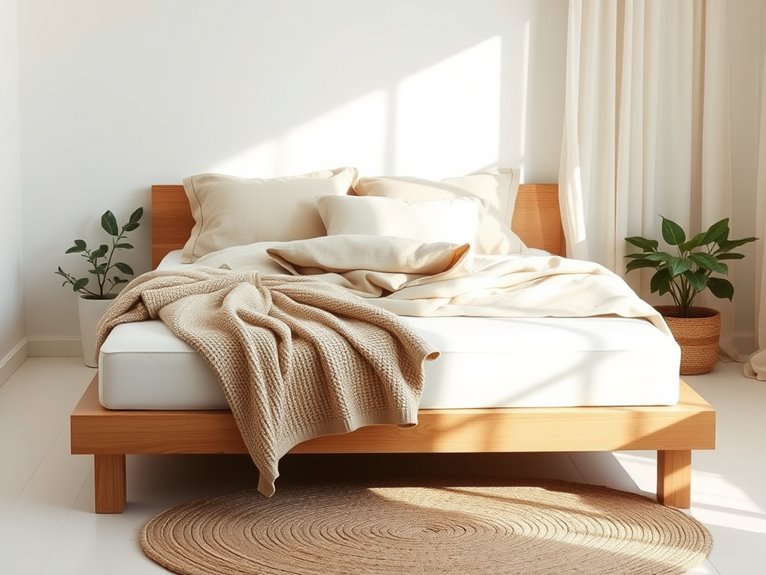
Natural latex mattresses represent the pinnacle of eco-friendly luxury bedding, featuring organic materials that create a clean, minimalist aesthetic. The natural cream color and subtle texture of latex mattresses pair beautifully with organic cotton sheets and natural fiber bedding, creating a serene and environmentally conscious bedroom setting that appeals to both modernist and naturalist design sensibilities.
This sustainable sleeping solution works particularly well in contemporary, Scandinavian, or eco-modern bedroom styles, where clean lines and natural materials take center stage. The versatility of natural latex mattresses allows them to complement any season, though they especially shine in summer months when paired with lightweight, breathable linens and cooling bamboo accessories.
Essential Components:
- Natural latex mattress
- Organic cotton mattress protector
- FSC-certified wooden bed frame
- Organic cotton sheets
- Natural wool or cotton duvet
- Organic cotton pillowcases
- Hemp or linen decorative throw
- Bamboo mattress topper (optional)
- Organic cotton pillow shams
- Natural fiber area rug
How to Achieve This Look
Begin with a solid foundation by selecting a natural latex mattress that’s certified organic and free from synthetic materials. Position it on a sustainable wooden bed frame that’s either unfinished or treated with non-toxic stains to maintain the pure, organic aesthetic.
Layer the bed with organic bedding in earth-toned colors like ivory, sage, or warm taupe. Start with a fitted sheet, followed by a flat sheet, and top with a natural wool duvet for temperature regulation. The key is to maintain clean lines while incorporating different textures through natural materials.
Choose accessories thoughtfully, focusing on sustainable materials and neutral colors that enhance the organic feel. Consider adding hemp throw pillows or a hand-woven cotton blanket at the foot of the bed. The overall color palette should remain soft and natural, incorporating shades of cream, beige, and gentle earth tones that reflect the mattress’s organic origins.
Pro Styling Tips
For maximum impact, incorporate different textures within the same neutral color family – think nubby organic cotton paired with smooth bamboo sheets and chunky knit throws. Scale the look to your room size by adjusting the number of decorative elements, keeping smaller spaces minimal with just two accent pillows and one throw.
To maintain the pristine appearance of your natural latex bed, rotate the mattress seasonally and use organic cleaning products specifically designed for natural materials. For warm weather, switch heavy wool elements for lightweight linen, and in cooler months, add layers of organic cotton blankets for warmth without compromising the sustainable aesthetic.
Organic Cotton Bedding Sets
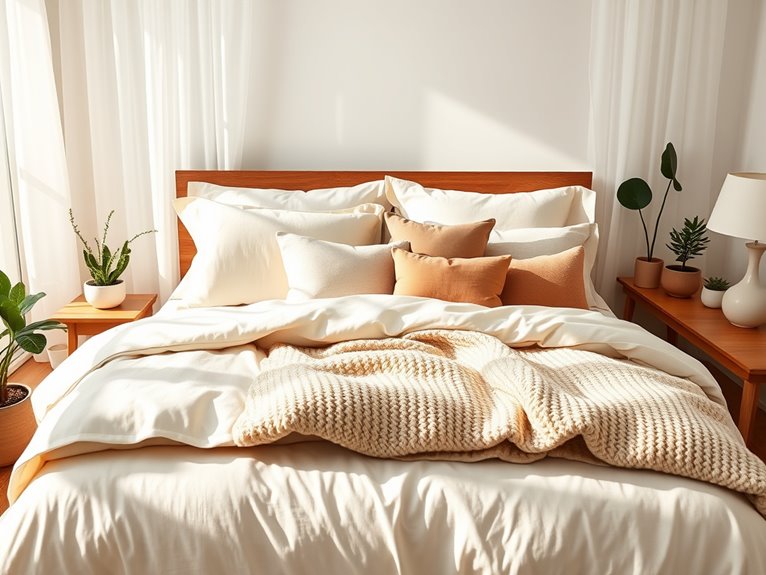
The timeless appeal of organic cotton bedding sets lies in their natural, understated elegance and cloud-like softness that instantly elevates any bedroom’s aesthetic. The gentle textures and pristine appearance create an inviting sanctuary that speaks to both luxury and environmental consciousness, with subtle variations in weave patterns adding depth and visual interest without overwhelming the space.
This styling technique works particularly well year-round but especially shines during warmer months when lightweight, breathable bedding is essential. Organic cotton sets complement various design styles, from modern minimalist to rustic farmhouse, making them incredibly versatile. The natural fibers create a clean, fresh look that pairs beautifully with both neutral color schemes and bold accent pieces.
Essential Components:
- Organic cotton fitted sheet
- Organic cotton flat sheet
- Organic cotton pillowcases (2-4)
- Organic cotton duvet cover
- Organic cotton bed skirt
- Euro shams (2-3)
- Decorative pillows in complementary fabrics
- Throw blanket
- Mattress protector
- Duvet insert
- Pillow inserts
How to Achieve This Look
Start by layering the foundational pieces, beginning with a high-quality mattress protector followed by the fitted sheet, ensuring corners are crisp and tight. The flat sheet should be tucked using hospital corners for a polished look, with the top edge folded down approximately 18 inches over the duvet.
The duvet cover should be steamed or pressed before dressing the bed, creating clean lines and removing any wrinkles. Position it so the top edge aligns with the mattress head, allowing natural draping along the sides. For visual interest, fold the top portion back to create a hotel-style turndown effect.
Layer Euro shams against the headboard, followed by sleeping pillows in their cases, arranged standing upright rather than lying flat. Add decorative pillows in odd numbers, mixing textures while maintaining a cohesive color palette. Neutral tones like ivory, warm white, and soft gray create a sophisticated foundation, while muted earth tones add organic warmth.
Pro Styling Tips
For a perfectly styled organic cotton bed that maintains its appeal, invest in multiple sheet sets to rotate weekly, preventing wear and maintaining that crisp, fresh appearance. Store folded items with lavender sachets to maintain freshness, and consider sizing up your duvet cover one size larger than your mattress for a luxuriously oversized look.
To prevent yellowing of white organic cotton, avoid using chlorine bleach and opt for oxygen-based alternatives, storing pieces away from direct sunlight when not in use.
Bamboo Platform Beds
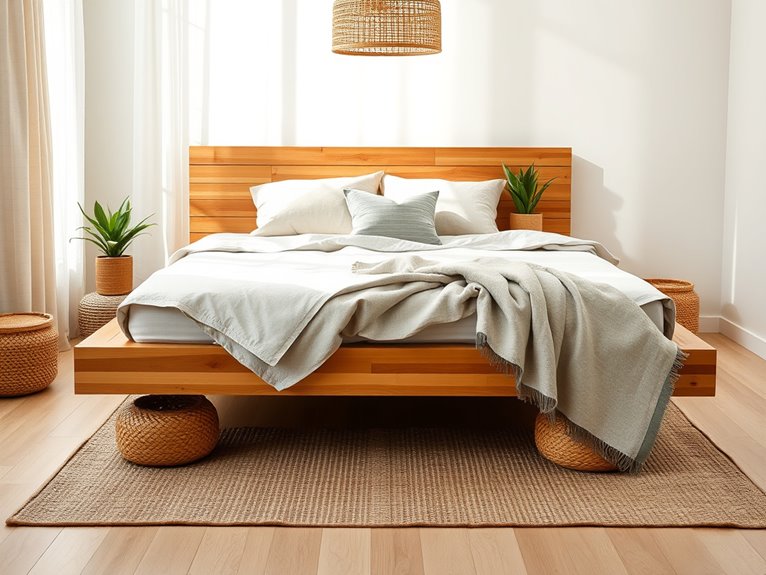
The natural elegance of bamboo platform beds brings an eco-conscious zen aesthetic to any bedroom space. The clean lines and organic texture of bamboo create a minimalist foundation that elevates the entire room while maintaining a connection to nature. The light honey tones and distinctive grain patterns of bamboo add warmth and visual interest without overwhelming the space.
This sustainable bed style works particularly well in modern, contemporary, and Asian-inspired interiors, making it versatile for year-round styling. Bamboo platform beds are especially fitting for spring and summer décor schemes, though they can be winterized with layers of warm textiles. The low-profile design creates an illusion of more space, making it ideal for both compact urban bedrooms and spacious master suites.
Essential Components:
- Bamboo platform bed frame
- Organic cotton or bamboo fiber mattress
- Natural linen sheets
- Bamboo fiber duvet cover
- Linen or cotton pillowcases
- Decorative bamboo throw pillows
- Woven grass floor mat
- Bamboo or rattan storage baskets
- LED accent lighting
- Natural fiber throw blanket
How to Achieve This Look
Begin by positioning the bamboo platform bed frame against the focal wall, ensuring equal space on both sides for balance. The low height of the frame should be emphasized rather than hidden, as it’s a key feature of the design. Install the mattress directly on the platform, avoiding box springs to maintain the minimalist profile.
Layer the bed with natural-toned linens, starting with fitted sheets in ivory or soft sage green. Add a duvet cover in complementary earth tones such as sandy beige or gentle gray. The key is to maintain a monochromatic or analogous color scheme that echoes the bamboo’s natural hue.
Incorporate subtle texture variations through different weaves and materials while staying within the natural fiber family. Arrange pillows in a deliberately casual manner, using no more than three layers of height. Position larger pillows at the back, medium-sized pillows in the middle, and one or two decorative pillows in front. The overall arrangement should appear effortless rather than formal.
When photographing the setup, capture the bed from a slight angle to highlight the platform’s clean lines and the textural interplay between different materials.
Pro Styling Tips
Create visual hierarchy by varying textile textures while maintaining a consistent color palette – this designer secret adds depth without compromising the zen aesthetic. For smaller rooms, keep bedding layers minimal and opt for lighter colors to maintain airiness; larger spaces can handle additional layers and deeper earth tones.
During cooler months, introduce warm throws and extra pillows, but maintain the clean lines by tucking excess fabric neatly. To preserve the bed’s pristine appearance with daily use, invest in quality bamboo-fiber bedding that resists wrinkles and keeps its shape after washing.
Hemp-Based Sleep Solutions

The natural, earthy elegance of hemp bedding creates a sophisticated yet relaxed aesthetic that instantly transforms any bedroom into an eco-conscious sanctuary. The distinctive texture of hemp fiber produces subtle variations in the fabric’s surface, creating a visually rich landscape of organic patterns and gentle shadows that become more beautiful with each wash.
The material’s natural oatmeal, ivory, and sand tones establish a serene foundation that complements both minimalist and bohemian design schemes. Hemp bedding proves particularly ideal for year-round use, adapting remarkably well to seasonal changes thanks to its temperature-regulating properties. This styling approach works exceptionally well in contemporary spaces with natural elements, Scandinavian-inspired rooms, or eco-modern interiors.
The breathable nature of hemp makes it perfect for warm climates while providing cozy comfort during cooler months, allowing for versatile styling options throughout the year.
Essential Components:
- Hemp fitted sheet
- Hemp flat sheet
- Hemp duvet cover
- Hemp pillowcases (2-4)
- Organic cotton or wool pillow inserts
- Hemp throw blanket
- Linen or hemp decorative cushions
- Natural fiber mattress protector
- Bamboo or wooden bed frame
- Jute or hemp area rug
- Plant-based fabric freshener
How to Achieve This Look
Begin by dressing the bed with a hemp fitted sheet, ensuring corners are tucked precisely for a smooth foundation. Layer with a flat sheet, allowing the natural creases to create organic texture rather than attempting perfectly crisp lines. The slightly rumpled appearance adds to the authentic, lived-in aesthetic that hemp naturally provides.
The duvet should be dressed in a hemp cover, preferably in a tone slightly different from the sheets to create subtle depth. Fold the top portion of the duvet back to reveal the sheets beneath, creating an inviting layered effect. Position pillows against the headboard, using a combination of standard sleeping pillows and decorative cushions in complementary natural tones.
Color combinations that work particularly well include varying shades of natural hemp (from light ecru to deeper taupe), accented with sage green, terracotta, or muted blue elements. When photographing this style, natural lighting is crucial – morning light especially highlights the organic texture and subtle variations in the hemp fabric.
Pro Styling Tips:
To maintain the naturally relaxed appearance of hemp bedding while keeping it photogenic, embrace its tendency to wrinkle organically rather than fighting it. For smaller rooms, stick to lighter hemp tones and minimize decorative elements to maintain an airy feel.
During warmer months, remove the duvet and use only the hemp flat sheet and a light throw blanket; in winter, layer multiple hemp textures for added warmth and visual interest. Daily maintenance is simple – lightly smooth the duvet each morning rather than making the bed with military precision, allowing the natural characteristics of hemp to create an effortlessly stylish appearance that improves with age.
Zero-Waste Futon Designs
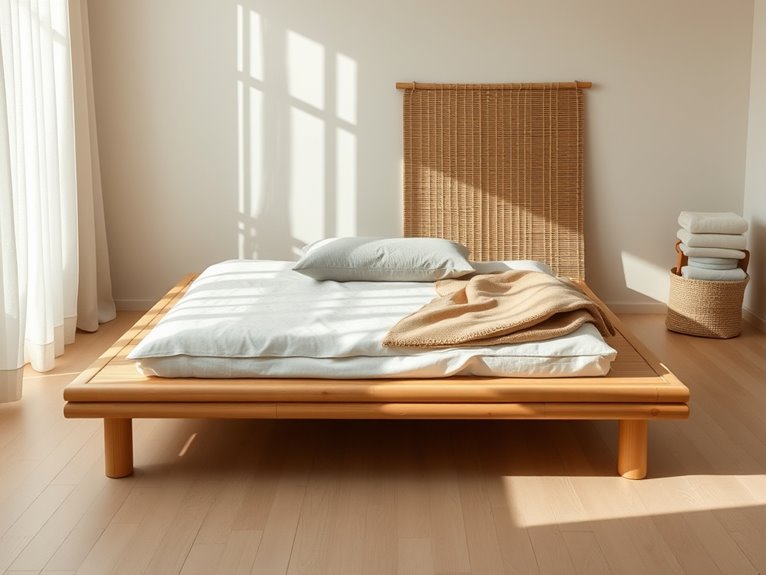
Zero-waste futon designs combine minimalist Japanese aesthetics with sustainable living principles, creating a sleep space that’s both environmentally conscious and visually serene. The clean lines and natural materials characteristic of these designs make them particularly striking in modern and contemporary spaces, while their adaptability allows them to seamlessly integrate into nearly any room configuration.
These designs work exceptionally well in smaller spaces or multipurpose rooms where flexibility is key. The style is particularly suited for year-round use, with the ability to adjust layers seasonally. Natural, undyed fabrics and recyclable materials create a neutral palette that promotes relaxation while maintaining a commitment to environmental responsibility.
Essential Components:
- Organic cotton or hemp futon mattress
- Natural fiber cover (linen or cotton)
- Bamboo or wooden platform base
- Organic cotton sheets
- Hemp or wool padding
- Buckwheat hull pillow
- Rolling mat for storage
- Natural fiber storage bags
- Coconut coir support layer
- Cotton twine for securing
How to Achieve This Look
Start by selecting a proper foundation – either a traditional tatami mat or a low-profile wooden platform made from sustainable materials. Position the platform away from walls to allow proper air circulation and create a floating effect that enhances the minimalist aesthetic.
Layer the futon mattress strategically, beginning with the support layer of coconut coir, followed by the main futon body. The mattress should be positioned precisely in the center of the platform, maintaining equal borders on all sides for visual balance.
Choose bedding in natural, undyed tones like ecru, wheat, and soft gray. Layer organic cotton sheets and covers using the traditional triple-fold method, which allows for easy storage and maintains the mattress’s shape. Incorporate seasonal adjustments by using lightweight hemp covers in summer and adding wool layers in winter.
Pro Styling Tips
Roll and store the futon daily to maintain its shape and cleanliness. This practice not only extends the life of the materials but also supports the zero-waste philosophy by preventing premature wear.
For smaller rooms, invest in wall-mounted storage solutions crafted from sustainable materials to keep the futon and bedding elevated when not in use. Create seasonal variation by switching between cool bamboo accessories in summer and warm organic wool accents in winter, while maintaining the core zero-waste principles through reusable, biodegradable materials.
Upcycled Pallet Bed Frames

Pallet bed frames represent the perfect fusion of industrial chic and eco-conscious design, transforming humble shipping materials into striking bedroom centerpieces. The raw wooden texture, combined with the geometric patterns created by the pallet construction, adds an organic architectural element that grounds any bedroom space while maintaining an air of modern sophistication.
This sustainable bed styling technique works particularly well in urban loft spaces, industrial-modern homes, or rustic farmhouse settings. The versatility of pallet frames allows them to transition seamlessly through seasons, though they particularly shine in summer months when paired with light, breezy textiles. The natural wood tones complement virtually any color palette while providing a neutral foundation for rotating decor schemes.
Essential Components:
- Wooden pallets (6-9 depending on bed size)
- Wood sealant or paint
- Heavy-duty castors (optional)
- Platform mattress
- Fitted sheet set
- Duvet or comforter
- 4-6 decorative pillows
- Throw blankets
- Sandpaper
- Power drill
- Wood screws
- Safety gear (gloves, goggles)
How to Achieve This Look
Begin by selecting pallets in good condition, preferably heat-treated and chemical-free. Sand all surfaces thoroughly to prevent splinters and create a smooth finish. Apply wood sealant or paint in your chosen shade, ensuring complete coverage for protection and aesthetics. Connect the pallets using heavy-duty screws, creating a stable platform slightly larger than your mattress dimensions.
Layer the bed starting with a quality platform mattress, as pallet frames work best with mattresses designed for flat surfaces. Choose bedding in natural materials like linen or cotton in earth tones such as cream, sage, or clay to complement the wooden structure. Add visual interest through textural contrast by incorporating both smooth and nubby fabrics in your pillow selection.
For optimal styling, maintain a balance between rustic and refined elements. Combine crisp white sheets with raw-edge linen throws, or pair industrial metal accents with soft, woven textiles. Earth-toned color schemes work exceptionally well, but don’t shy away from introducing bold accent colors through pillows or artwork above the bed.
When photographing, capture angles that highlight the geometric patterns of the pallets and the layered textures of the bedding.
Pro Styling Tips
Save time and effort by selecting pallets of uniform size and quality from the start, and consider adding castors for easy mobility during cleaning. Scale your pallet platform according to room size – for smaller spaces, create a flush fit with the mattress, while larger rooms can accommodate an extended platform for built-in nightstand surfaces.
To maintain the look, regularly dust between pallet slats and rotate textiles seasonally, switching to warmer textures and deeper colors in winter months, and lighter, breezier options in summer. Keep the wood sealed and maintained to prevent splinters and extend the life of your sustainable bed frame.
Cork and Natural Fiber Foundations
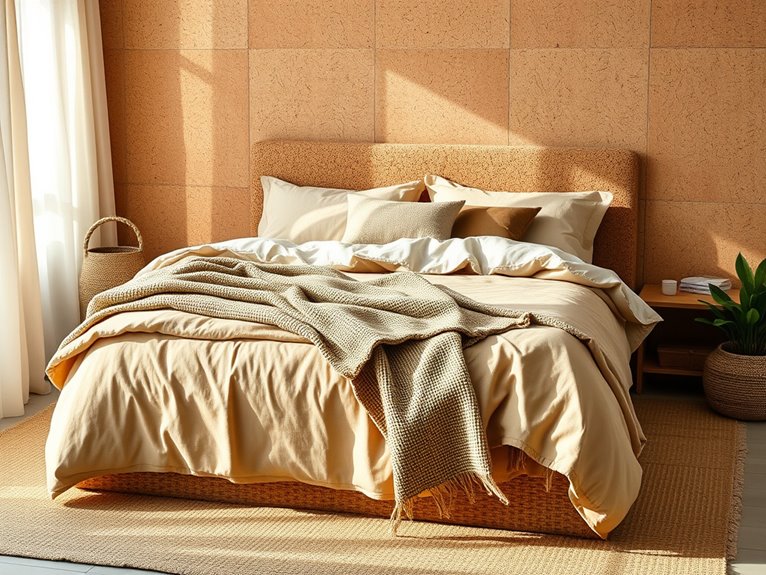
Cork and Natural Fiber Foundations create a warm, organic aesthetic that brings an eco-conscious approach to bedroom design. The combination of cork’s unique textural patterns and natural fibers like jute, sisal, and hemp produces a visually striking foundation that feels both contemporary and timeless.
These materials create subtle variations in tone and texture, adding depth to the bedroom while maintaining a serene, earth-focused atmosphere. This sustainable styling technique works particularly well in modern minimalist spaces and rooms with a biophilic design focus.
It’s especially suitable for year-round use, though it feels most harmonious during spring and summer months when natural light can highlight the organic textures. The style adapts beautifully to both urban and rural settings, offering excellent temperature regulation properties while providing a grounding aesthetic that promotes restful sleep.
Essential Components:
- Cork headboard or bed frame
- Natural fiber mattress foundation
- Organic cotton sheets
- Hemp or linen duvet cover
- Jute area rug
- Sisal or seagrass accent pieces
- Bamboo throw pillows
- Cork wall panels (optional)
- Natural fiber window treatments
- Plant-based textile throws
How to Achieve This Look
Begin by selecting a cork-based bed frame or headboard as your anchor piece. The natural variations in cork create an immediate visual interest and serve as a neutral backdrop for layering additional natural materials.
Install cork wall panels behind the bed if desired, creating a cohesive backdrop that enhances acoustic properties. Layer the bed with organic textiles, starting with a natural fiber mattress foundation and organic cotton sheets.
Choose colors that echo cork’s warm tones – think wheat, sand, and soft earth tones. Add visual depth by incorporating different natural fiber textures through pillowcases and throws, ensuring each element maintains the organic theme while providing textural contrast.
For the finishing touches, incorporate sisal or jute accessories to complement the cork elements. Position a natural fiber area rug beneath the bed, extending at least 24 inches on each side to create a balanced foundation.
Ensure proper lighting to highlight the natural variations in the materials – indirect natural light works best to showcase the organic textures without creating harsh shadows.
Pro Styling Tips
For maximum impact, maintain a 60-30-10 ratio when combining different natural materials – 60% cork elements, 30% natural fiber textiles, and 10% accent materials.
Scale the size of textural elements according to room dimensions, using larger patterns in spacious rooms and finer textures in compact spaces. To preserve the cork and natural fiber elements, regularly dust with a soft brush and avoid exposure to direct sunlight, which can cause uneven fading.
Consider rotating textiles seasonally while maintaining the cork foundation to keep the look fresh – lighter linens for summer and weightier hemp textiles for winter months.
